The Blog
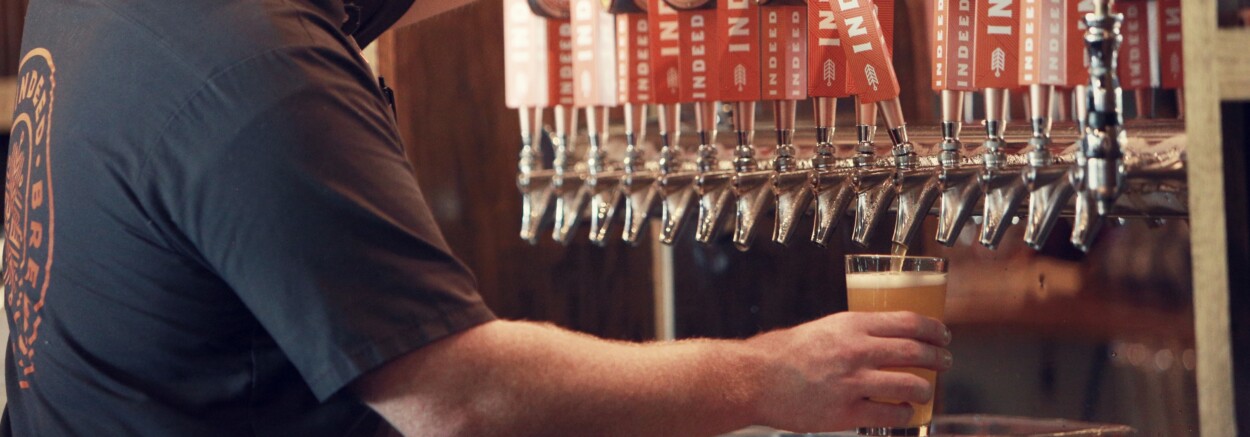
Dec 8/15
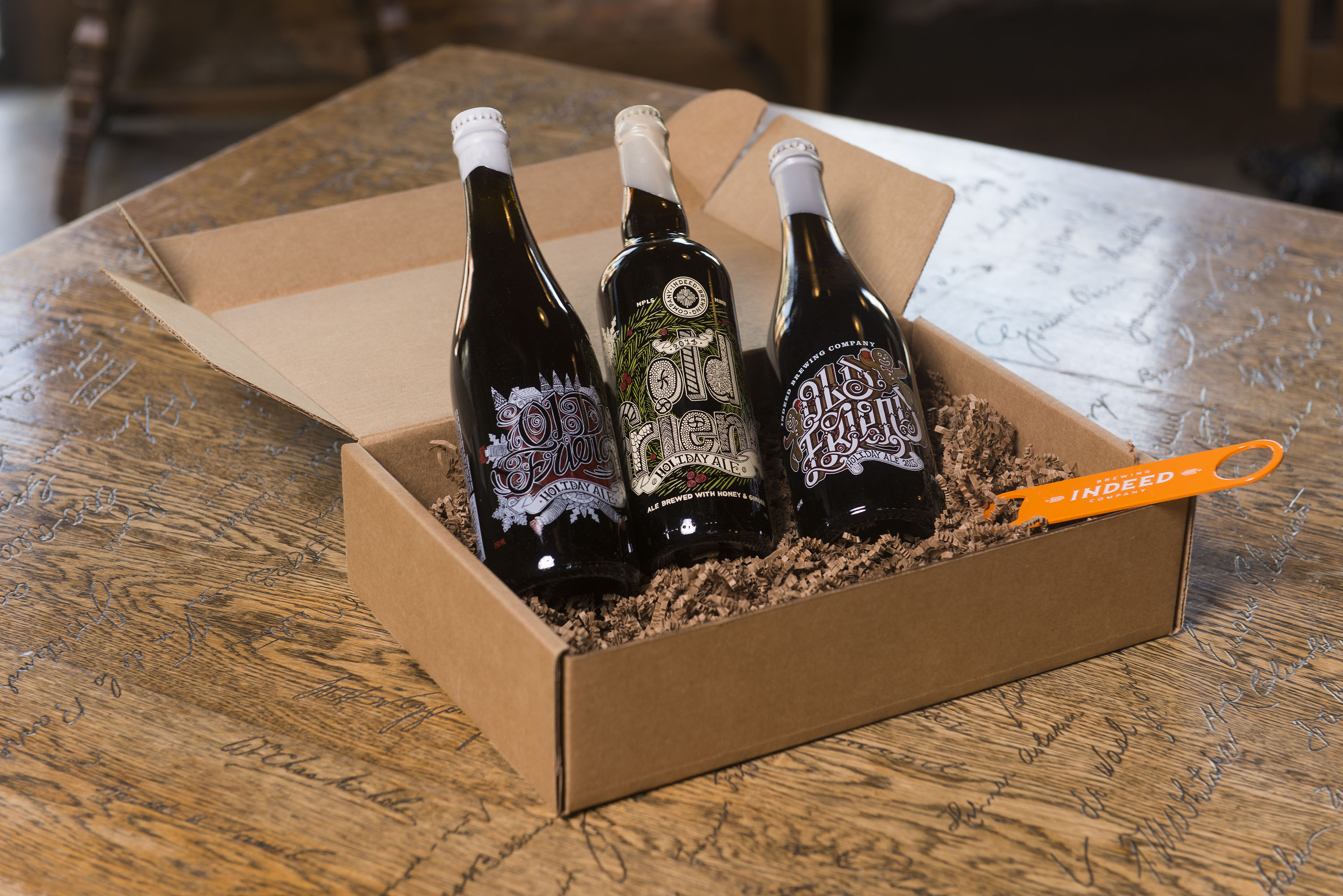
Better with age? Our QC Manager breaks down cellaring beer
Cellaring it. Aging it. Saving it for a rainy day. If you can resist the temptation to crack open your brand new bottle of Rum King or Old Friend, intriguing things can happen over time. But knowing which beers to age, and for how long, and why, can be confusing, and no one wants to spoil a perfectly good bottle of beer in the long run. We asked our Quality Control Manager Daniel Howell to break it down, so you can sally forth into your cellaring foray with confidence!
How long should I age my beer?
At Indeed, we package beer that our brewers deem ready to consume. Your beer does not need to be aged at all. However, many beer drinkers find that the character of beer changes and sometimes changes for the better as a beer is aged. These interesting and enjoyable changes typically occur in higher alcohol beers.
How will my beer change over time?
Typically beer enthusiasts describe aged beer to be more mellow and more complex. This may be due to a number of factors, but this is likely due to oxidation of the malt components that may further meld with and possibly mask the alcohol in the beer. As beer sits undisturbed, small particulates also settle out (which will change the flavor of a beer). If honey was used in the beer, the flavor profile of the honey tends to come to the forefront and develop nicely with some age on it. For example, the aging of LSD goes through a number of interesting changes. In its youngest stage the lavender has historically dominated the profile. With time the lavender, while still present, becomes more of a "team player" than "spot light" stealer. The play between the caramel flavors of the dates and toasty-ness of the malt comes out more. Also as I have found with all honey beers, with time the honey character really starts to come out and shine through. With time there is a cinnamon character that develops and I'm not exactly sure which component or combination is responsible.
Where should I store aging beer?
Beer should be aged at “cellar temperatures.” Typically this is around 45-50 degrees F. Warmer temperatures will speed up aging reactions and may lead to undesirable flavors (described as paper and cardboard). Cooler temperatures will not harm the beer but will slow the aging process. Beer should always be kept in a dark location.
How long is too long to age my beer?
Beer should be aged long enough, but not longer. This is a very hard question to answer. The beer changes as it ages in an manner that is not completely predictable. If you have an aged beer that is good, it could get better but it could also get worse. This is the gamble that has to be made when aging beer.
Why does beer change in flavor over time?
The primary change in beer flavor in time comes from oxidation. When beer is packaged, a small amount of oxygen is trapped in the package. This, along with the small amount of oxygen that can “creep” in over time, leads to slow oxidation of the malt. This oxidation typically creates sweet, caramel-like characters and can even give beer a sherry-like flavor and aroma. Time and, again, oxygen can also change the character of the hops. The aroma and flavor of hops tend to disappear and the bitterness can become more aggressive.
How can I tell if my beer is too old?
The changes in the flavor associated with oxidation will become stronger and more pronounced as the beer ages. When these flavors are no longer enjoyable, the beer is too old. An easy way to tell if a beer is too old is to check the date code on the package. At Indeed, we include batch numbers and “Best By” dates on our cans and 12 packs. Not all breweries date code their packaged beer, but at Indeed we think it’s vital that the customer has all the information they need to make an informed purchase. Buying fresh beer shouldn’t be a game of roulette.
Are Indeed beers made to be aged?
We expect all of our higher-alcohol specialty beers to age well (LSD, Rum King, Old Friend, and Mexican Honey). If you buy one of our specialty beers in a 750 ml bottle and it is wax finished, this beer should age well. We do not recommend aging our year-round or seasonal 12 oz. can offerings; these beers are meant to be consumed fresh. For all canned beer, check the bottom for the best by date.
Thanks, Daniel! And if all this talk of aged beer has whet your whistle, we've got just the ticket, just in time for the holidays: curated gift sets for giving or receiving, including a Rum King vertical ('14, '15), 2015 vintages of Hot Box and LSD, and a lovely three year vertical of Old Friend Holiday Ale. Gift sets are available while supplies last in our Gear Shop, open Wednesday-Sundays.
Aug 13/15
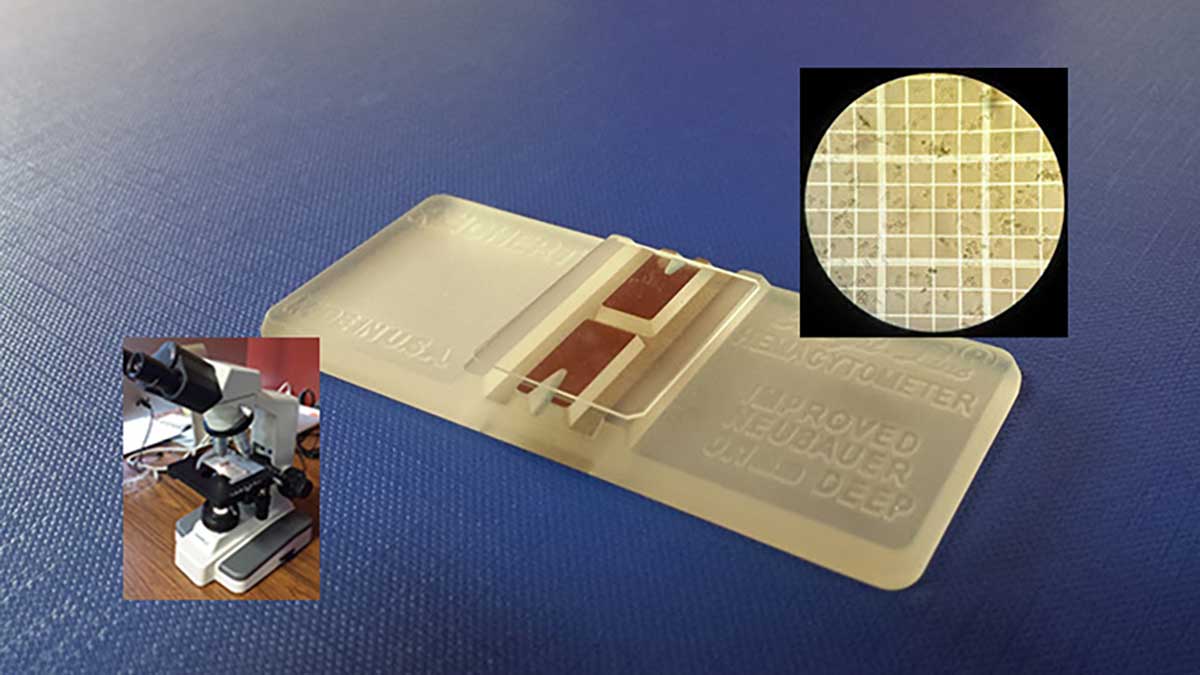
Quality Manager Daniel Howell expands on the magical powers of yeast
The next time you take a sip of that beautiful beer in your hand, don't take it for granted! Stop and thank the hard-working yeast responsible for the magic in that glass. Behind all those bubbles and booze are trillions of yeast cells carefully cultivated and coddled by our brewers to turn wort into beer. It's not rocket science, technically, but there's actually a lot of science involved, so we asked our Quality Manager Daniel Howell to drop some knowledge on us about yeast.
What is yeast?
Technically speaking, yeast are unicellular fungi. When talking about brewers yeast, there are two important species: Saccharomyces cerevisiae (ale yeast) and Saccharomyces pastorianus (lager yeast) with each species having countless strains. While there is a lot of variation among different strains, the vast majority of the beer in the world is made by 2 of these two species.
What is the difference between ale and lager yeast? Ale yeast are typically used at warmer fermentation temperatures (65-70°F+) and lager yeast are typically used at cooler fermentation temperatures (45-55°F). The differences in the fermentation temperature helps drive the differences in the resulting beers. Ales tend to ferment a little quicker and produce more fruity characters (think apple, pear, berry, and banana). Lagers tend to ferment slower and are sometimes described to be "smoother" or "crisp" (which is a combination of fewer fruity and more sulfur compounds).
What does yeast do for us? For the beer?
Well, the real question should be "what do we do for the yeast?" In the brewhouse, almost all the steps in brewing are performed with one thing in mind: keep the yeast happy. In return for making them happy, the yeast transform the wort (sugar, bitter malty water) into a tasty, fizzy, alcoholic beverage.
So, what makes the yeast happy? How do you know they are happy?
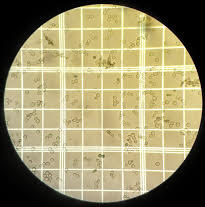
In general, yeast want two things: to eat and to reproduce. Yeast's food of choice is sugar, which we oblige by providing them with malt-derived carbohydrates in the wort. To reproduce (which is referred to as budding), the yeast need energy (from the sugar) and oxygen to help build new cellular material. To determine if the yeast are happy, we can take a small sample of the yeast and look at them under the microscope. In the picture here, you can see a few cells that are darker blue in color. These cells are what we refer to as "non-vaible." When we are using yeast to make beer, we want as few non-viable cells as possible.
How much yeast does it take to make beer?
A lot. For example, in Day Tripper, we aim to start fermentation with 9 million yeast cells per milliliter of beer. That means in our standard 60 barrel (1,860 gallon) fermenter we use 63 trillion yeast cells. This number depends on the beer and is typically double in lagers (you need more yeast for the cold fermentation). To count the amount of yeast in a given sample, we use a special device called a hemocytometer which allows us to place a precise amount of liquid in a grid and look at it under the microscope. By counting the amount of yeast in the grid, we can determine the number of yeast per milliliter of sample.
Where do you get all that yeast?
We purchase our house ale and lager yeast from a supply company (Wyeast Laboratories). Luckily, in the process of making beer, the yeast also reproducing making more yeast. In most beers, the amount of yeast will increase 3 to 5 fold. So, that means from 1 batch of Day Tripper, for example, we will have enough yeast for 3-5 subsequent beers.
How do you get the yeast from one beer to the next?
At Indeed we use fermenters that have a cone-shaped bottom. When the yeast is done fermenting, it clumps together (flocculates) and settles out. The sloped sides of the tank concentrate the yeast to the bottom. When we are ready to use the yeast, a brewer connects a special modified keg to the bottom of the tank and collects a certain amount of yeast. By taking a sample of the yeast and counting it in the lab, we know exactly how many pounds of yeast need to be added to the next batch.
How many times do you re-use the yeast? And what do you do with it when you are done?
We re-use our yeast in about 10 fermentations before we bring in a new supply. Overuse can result in changes in the flavor profile of the beer and may result in poor or slow fermentation. Most of our yeast is removed using our centrifuge separator.
So what have we learned today? If the fungi are happy, everybody's happy. Thanks for the lesson on the power of yeast, Daniel!
May 26/15
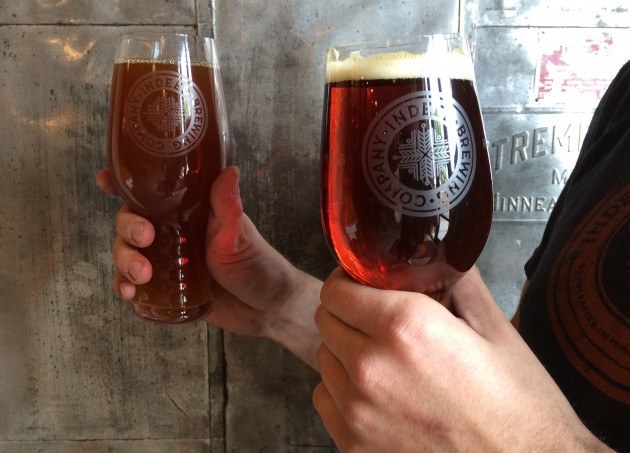
Indeed's Quality Manager Daniel Howell clears the air on hazy beer
Let it Ride IPA, two ways: Hazy, turbid beer on the left; clear, bright beer on the right, after a spin in the centrifuge.
The topic of beer clarity can get a little, ahem, hazy. So we sat down with Indeed Brewing Company's Quality Manager Daniel Howell to see if he could shed some light on a cloudy subject.

Daniel Howell, Quality Manager
What is beer clarity? Why does it matter?
Clarity is simply how clear a beer is or, in technical terms, a lack of turbidity. Chefs often say that you eat with your eyes first, and I would contend it is the same for beer. The clarity of a beer is the first impression that we, the brewers, get to make with the consumer. The desired clarity of our beer can vary from brand to brand from hazy, like Shenanigans Summer Ale, to very bright, like Let it Ride IPA. Whatever the style, we strive to achieve consistent clarity in every can or pint of Indeed beer consumed.
What causes haze?
When fermentation is complete, all beer is hazy and turbid. The overall turbidity of the beer can have contributions from all the ingredients that go into making beer, including yeast, malt, and hops.
Does Indeed filter their beer?
Most of the beer produced worldwide is filtered. However, at Indeed we have decided not to filter our beer. Filtering strips some of the natural character from the beer, and we've decided that we would prefer to present a beer to our customers that has the maximum possible character. Filtration also creates a large amount of waste. After filtration, the filter medium must be disposed of and, while compostable options do exist, this disposal typical means more refuse that is destined for the landfill.
What does Indeed do to reduce the haze in their beer?
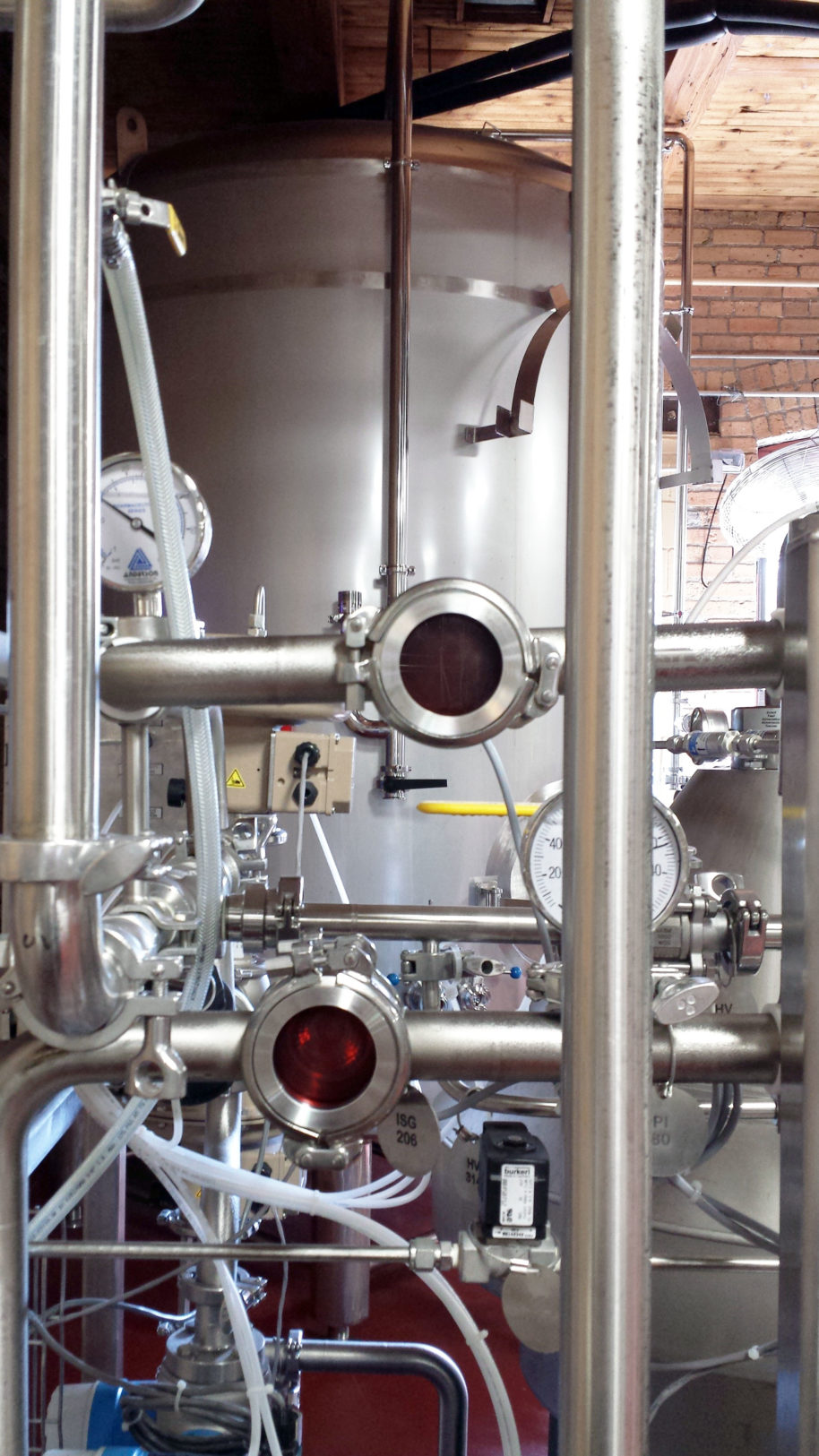
Without filtration, there are three primary options to reduce haze in our beer: time, temperature, and "accelerated gravity" from our centrifuge.
- After fermentation is complete, all of Indeed's beers spend time in the fermentation tank conditioning, which allows the haze-causing particles to form and settle.
- After fermentation is complete, our beer is cooled to approximately 32F (or colder) to encourage haze particle to settle.
- If left cold for enough time, most of beer would become exceptionally bright. But, for many of our beers, that means we would be selling an already aged product. Instead, we use a centrifuge separator that, in a sense, "accelerates" gravity. The beer passing through a series a plates that are spinning very fast such that the particles in the beer are thrown to the side and the clear beer passes through.
After all that, why do I sometimes get hazy Indeed beer?
After our beer is centrifuged, it is very clear. But after centrifugation, the beer packaged, and exposed to a rather harsh environment: turbulence, oxygen and heat. All these "enemies of beer" combine to promote the combination of malt proteins and hop polyphenols. These newly formed particles start small and get bigger as the beer continues to age. Initially, these new particles are only visible when the beer is cold and will re-dissolve when the beer is warmed. Thus, this is aptly named "chill haze". As the particle grow even larger, they no longer re-dissolve when warmed and are referred to as "permanent haze".
How does this haze effect my beer?
The simple answer is that it doesn't. Neither of these forms of haze are more than cosmetic. They do not affect the flavor, aroma, or mouthfeel of the beer at all.
